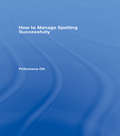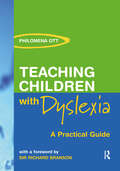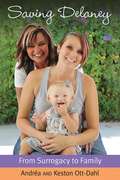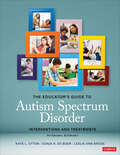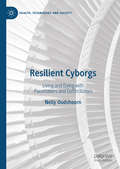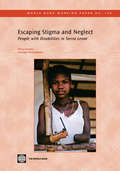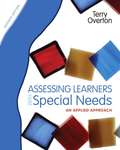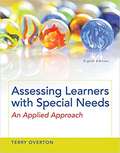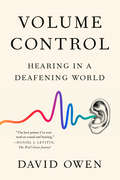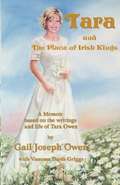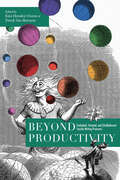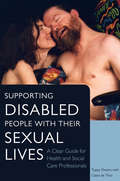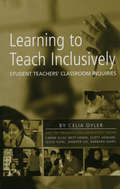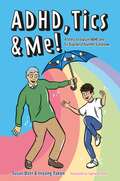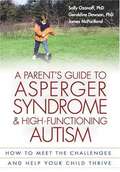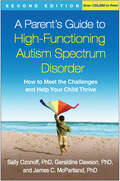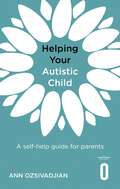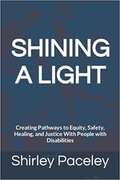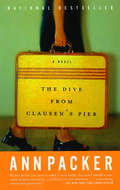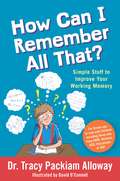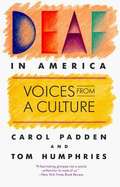- Table View
- List View
How to Manage Spelling Successfully
by Philomena OttReaders will find this practical and comprehensive guide to spelling invaluable. Day-to-day advice on how to help those with difficulties is underpinned by information on the development of the English language and its spelling rules with explanations of common language problems. Chapters cover: spelling processes teaching and learning phonics individual cognitive and learning styles assessing and monitoring spelling progress teaching strategies and techniques. This is an essential companion for teachers, SENCos, and dyslexia specialists alike, as well as anyone interested in spelling and language difficulties.
Teaching Children with Dyslexia: A Practical Guide
by Philomena OttTeaching Children with Dyslexia is essential reading for any teacher, Special Educational Needs Co-ordinator or teaching assistant who wants an insider's account of what dealing successfully with dyslexia entails.Written by one of the most well-regarded practitioners in the field with over twenty-five years' experience, this book is packed full with photocopiable exercises, activities and recommendations for resources, tests, teaching methods, advice and suggestions for strategies and techniques that are instantly transferable to classroom environments. This essential teaching companion includes chapters on: how to spot dyslexia screening and assessment tests why it does not have to be hell to learn to spell strategies for success for reluctant writers meeting the challenge of dyslexia in adolescence. Written specifically to bolster teachers' confidence and empower them with the key to unlocking literacy problems in their most challenging pupils, this resource book should be on the shelf of every staff room.
Saving Delaney: From Surrogacy to Family
by Keston Ott-DahlSaving Delaney is the heartwarming true story of a special needs baby and the unconventional family who fought for her right to life. Andrea Ott-Dahl, who with her wife Keston Ott-Dahl has two other children, agreed to act as a pregnancy surrogate for a wealthy Silicon Valley couple. When pre-natal testing revealed the baby would be born with Down Syndrome, Andrea was urged to abort the child. Instead, the Ott-Dahls chose to adopt and raise the daughter they would call Delaney, navigating legal, medical and emotional challenges. Despite heart surgery and an array of other challenges, Delaney at age 3 is alive, thriving, and an inspiration to every loving parent on the planet.
The Educator′s Guide to Autism Spectrum Disorder: Interventions and Treatments
by Kaye L. Otten Sonja R. de Boer Leslie Ann BrossIdentify the best interventions to fit the unique needs of each learner with autism Whatever your role—general or special education teacher, school counselor, therapist, behavior analyst, administrator—you undoubtedly interact with learners with autism spectrum disorder (ASD) and are committed to helping them succeed and thrive. This easy-to-use accessible guide summarizes more than 75 interventions and rates each based on the most recent evidence of effectiveness and safety. Features include: A summary of interventions and treatments from a comprehensive variety of domains organized into 11 categories, including behavioral interventions, visual supports, social and emotional skills training, and physiological interventions, as well as interventions that have the potential for causing harm An evidence-based five-point scale that clearly rates each intervention’s effectiveness for specific learners Guidance for working with colleagues and families to choose and implement the most promising treatments Written by educators with decades of experience and expertise in a variety of settings, many of whom are also Board Certified Behavior Analysts, this comprehensive guide is an indispensable resource for all those who serve students with ASD.
The Educator′s Guide to Autism Spectrum Disorder: Interventions and Treatments
by Kaye L. Otten Sonja R. de Boer Leslie Ann BrossIdentify the best interventions to fit the unique needs of each learner with autism Whatever your role—general or special education teacher, school counselor, therapist, behavior analyst, administrator—you undoubtedly interact with learners with autism spectrum disorder (ASD) and are committed to helping them succeed and thrive. This easy-to-use accessible guide summarizes more than 75 interventions and rates each based on the most recent evidence of effectiveness and safety. Features include: A summary of interventions and treatments from a comprehensive variety of domains organized into 11 categories, including behavioral interventions, visual supports, social and emotional skills training, and physiological interventions, as well as interventions that have the potential for causing harm An evidence-based five-point scale that clearly rates each intervention’s effectiveness for specific learners Guidance for working with colleagues and families to choose and implement the most promising treatments Written by educators with decades of experience and expertise in a variety of settings, many of whom are also Board Certified Behavior Analysts, this comprehensive guide is an indispensable resource for all those who serve students with ASD.
Resilient Cyborgs: Living and Dying with Pacemakers and Defibrillators (Health, Technology and Society)
by Nelly OudshoornThis book examines how pacemakers and defibrillators participate in transforming life and death in high-tech societies. In both popular and medical accounts, these internal devices are often portrayed as almost magical technologies. Once implanted in bodies, they do not require any ‘user’ agency. In this unique and timely book, Nelly Oudshoorn argues that any discourse or policy assuming a passive role for people living with these implants silences the fact that keeping cyborg bodies alive involves their active engagement. Pacemakers and defibrillators not only act as potentially life-saving technologies, but simultaneously transform the fragility of bodies by introducing new vulnerabilities. Oudshoorn offers a fascinating examination of what it takes to become a resilient cyborg, and in the process develops a valuable new sociology of creating ‘resilient’ cyborgs.
Bioethics and Disability
by Alicia OuelletteBioethics and Disability provides tools for understanding the concerns, fears, and biases that have convinced some people with disabilities that the health care setting is a dangerous place and some bioethicists that disability activists have nothing to offer bioethics. It wrestles with the charge that bioethics as a discipline devalues the lives of persons with disabilities, arguing that reconciling the competing concerns of the disability community and the autonomy-based approach of mainstream bioethics is not only possible, but essential for a bioethics committed to facilitating good medical decision making and promoting respect for all persons, regardless of ability. Through in-depth case studies involving newborns, children, and adults with disabilities, Bioethics and Disability proposes a new model for medical decision making that is both sensitive to and sensible about the fact of disability in medical cases. Disability-conscious bioethics will bring together disability experts and bioethicists to identify and mitigate disability bias in our health care systems.
Escaping Stigma and Neglect: People with Disabilities in Sierra Leone
by Mirey Ovadiya Giuseppe ZampaglionePeople with disabilities in Sierra Leone are disadvantaged in regards to their access to social services and the economic opportunities available to them. Oftentimes, they are marginalized and their rights are ignored. The government of Sierra Leone is taking measures to improve the social and economic situation of people with disabilities in the country. The objective of this note on people with disabilities in Sierra Leone is to: (i) provide a diagnosis on the scale and nature of the problem, (ii) analyze current public policies in support of people with disabilities, (iii) review public and private programs, and (iv) propose policy options to policy makers and development partners. It is meant for policy makers and practitioners in Sierra Leone as well as all those interested in the subject.
Technology for All Assistive Technology in the Classroom
by Overbrook School for the BlindAn easy-to-read, field tested resource for all schools and colleges that need assistive technology in the classroom.
Assessing Learners With Special Needs: An Applied Approach (Seventh Edition)
by Terry OvertonAssessing Learners with Special Needs: An Applied Approach, seventh edition, is a practical book designed to teach you about the complex procedures of the assessment process. Each chapter starts out with a chapter focus that contains CEC Knowledge and Skills Standards that show you what you are expected to master in the chapter. Concepts are presented in a step-by-step manner followed by exercises that help you understand each step. Portions of assessment instruments, protocols, and scoring tables are provided to help you with the practice exercises. Additionally, you will participate in the educational decision-making process using data from classroom observations, curriculum-based assessment, functional behavior assessment, and norm-referenced assessment. New to the seventh edition: An emphasis on progress monitoring, including progress monitoring applied to the acquisition of knowledge and skills presented in this text The assessment process according to the regulations of IDEA 2004 A separate chapter on transition issues and assessment A separate chapter on assessment in infancy and early childhood A new chapter on the measurement aspects of Response to Intervention Increased consideration of students from culturally and linguistically diverse backgrounds in the assessment process
Assessing Learners With Special Needs: An Applied Approach
by Terry OvertonAssessing Learners with Special Needs: An Applied Approach, 8/e provides readers with a practical, step-by-step approach to learning about the complex procedures of the assessment process. This new edition provides a new presentation format and a new format for assessing student mastery of material through interactive learning activities.
Volume Control: Hearing in a Deafening World
by David OwenThe surprising science of hearing and the remarkable technologies that can help us hear betterOur sense of hearing makes it easy to connect with the world and the people around us. The human system for processing sound is a biological marvel, an intricate assembly of delicate membranes, bones, receptor cells, and neurons. Yet many people take their ears for granted, abusing them with loud restaurants, rock concerts, and Q-tips. And then, eventually, most of us start to go deaf.Millions of Americans suffer from hearing loss. Faced with the cost and stigma of hearing aids, the natural human tendency is to do nothing and hope for the best, usually while pretending that nothing is wrong. In Volume Control, David Owen argues this inaction comes with a huge social cost. He demystifies the science of hearing while encouraging readers to get the treatment they need for hearing loss and protect the hearing they still have.Hearing aids are rapidly improving and becoming more versatile. Inexpensive high-tech substitutes are increasingly available, making it possible for more of us to boost our weakening ears without bankrupting ourselves. Relatively soon, physicians may be able to reverse losses that have always been considered irreversible. Even the insistent buzz of tinnitus may soon yield to relatively simple treatments and techniques. With wit and clarity, Owen explores the incredible possibilities of technologically assisted hearing. And he proves that ears, whether they're working or not, are endlessly interesting.
Tara and the Place of Irish Kings: A Memoir Based on the Writings and Life of Tara Owen, June 18, 1973 - October 24, 2001
by Gail Joseph Owen Vanessa Davis GriggsTara Owen was born with cystic fibrosis (CF). A beautiful young woman, she fought courageously to live life on her own terms. She continued to fight for over 28 years, until a tragic error brought her battle to an end. This story is not about her death; it's about her life. Smart, beautiful, and full of love with so much to live for, yet she had every reason to have had an understandably lousy attitude. Tara's story will fill you with hope and a sense of purpose. Facets of her life are included in this story where wisdom nuggets permeate. With such love for family and a fondness for a farm she called, "The place fit for Irish kings," this story is a celebration of Tara's life and the people that meant the most to her. The reality of the illness she bravely battled will be part of the story. How else could her story be told? It's an account of perseverance, hope, love, and the desire to live life to its fullest. We'll take the journey with Tara from birth until her death. And in the space of her life, we'll learn what it means to love and to triumph through adversity, regardless. Twenty-eight years may not be long for many, but when one has inside them the heart of kings, great times and a life of love and being loved will somehow encompass you.
Beyond Productivity: Embodied, Situated, and (Un)Balanced Faculty Writing Processes
by Kim Hensley Owens Derek Van IttersumIn Beyond Productivity, a wide range of contributors share honest narratives of the sometimes-impossible conditions that scholars face when completing writing projects. The essays provide backstage views of the authors' varying approaches to moving forward when the desire to produce wanes, when deciding a project is not working, when working within and around and redefining academic productivity expectations, and when writing with ever-changing bodies that do not always function as expected. This collection positions scholarly writers' ways of writing as a form of flexible, evolving knowledge. By exhibiting what is lost and gained through successive rounds of transformation and adaptation over time, the contributors offer a sustainable understanding and practice of process—one that looks beyond productivity as the primary measure of success. Each presents a fluid understanding of the writing process, illustrating its deeply personal nature and revealing how fragmented and disjointed methods and experiences can highlight what is precious about writing. Beyond Productivity determines anew the use and value of scholarly writing and the processes that produce it, both within and beyond the context of the losses, constraints, and adaptations associated with the COVID-19 pandemic.
Supporting Disabled People with their Sexual Lives: A Clear Guide for Health and Social Care Professionals
by Tuppy OwensMany health and social care professionals today feel untrained, fearful and ill-equipped to support their disabled patients, clients and service users in their sexual lives. The result is that disabled people can be left feeling frustrated and afraid that their sexual needs will be forever unrecognised and unmet. This is a straight-talking guide to supporting disabled people with their sexual lives. It covers the range of difficulties disabled people experience, from physical limitations to problems such as lack of acceptance, knowledge and skills. The real difficulties professionals experience are also covered with positive suggestions, and a chapter on communication discusses how to discuss sex. Sections follow on the sexual services available to help, and the wide range of sexual diversities which disabled people can and do enjoy. A chapter by Claire de Than covers the law. This clear, down-to-earth guide will be essential reading for all those working with or supporting disabled people, from care home workers and managers to social workers, medical staff and therapists.
Learning to Teach Inclusively: Student Teachers' Classroom Inquiries
by Celia OylerThis book—co-authored by a teacher educator, a diverse group of five pre-service student teachers, and their student teaching supervisor—takes a unique, illuminating look at the experience of student teaching from the perspective of student teachers. It is premised on learning to teach as an inquiry process enriched by collaborative conversations. Readers are invited into student teachers’ dilemmas and decisions as they negotiate between their public school placements and their university-based coursework. Throughout the year of student teaching, the authors document their discussions and reflections about teaching in inclusive classrooms that shed light on the complex process of learning to teach and also offer insights into issues of teaching for equity. Each of the central chapters is written by an individual student teacher and tracks a specific question over the course of two semesters. Topics include: *contrasting models of inclusion and teachers’ differing orientations toward issues of community, difference, and normalcy;*how teachers foster peer relationships;*classroom management and discipline; *heterogeneous instruction; and*school-wide culture and systems that promote or mitigate against inclusion. A new perspective on what can be learned from student teaching is provided by the student teachers’ supervisor. In the concluding chapter, the teacher educators address the connections among the student teachers’ inquiries and offer an analysis from a disability studies/disability rights perspective on how inclusion fits into a social (rather than a medical) model of disability. All of the authors of this book seek to contribute to conversations that place advocacy, inquiry, contestation, and challenge at the center of the teacher’s role. This volume is their invitation to readers to join in a larger conversation about the challenges of, and necessity for, becoming inclusive teachers. Learning to Teach Inclusively is intended for inservice and preservice courses in elementary education, inclusion, and teacher research, and for field experience seminars. It is also suitable for graduate courses in teacher research, supervision, and research in teacher education.
ADHD, Tics & Me!: A Story to Explain ADHD and Tic Disorders/Tourette Syndrome
by Susan Ozer Inyang TakonMeet Jamie, a young boy with ADHD and a tic disorder called Tourette Syndrome. He's not being fidgety or naughty - he really can't help it! Jamie explains how he was diagnosed and what having tics and ADHD is like for him. He also shares how he has learnt to relieve his ADHD symptoms, minimise his tics, and how friends and adults can help at home and school.This illustrated book comes in two parts - one with interactive activities and heaps of useful information about having both ADHD and tics. Jamie explains how it can be really tricky to tell whether your fidgeting comes from having ADHD, tics, or both! The second part tells the story of how Jamie's Grandfather encouraged him to learn more about his tics. Jamie and his friends who attend the after-school tic club learn about each other by sharing their experiences of ADHD and tics at home and at school.This book is ideal for children aged 7+ as well as friends, teachers and professionals working with children with ADHD and tic disorders, and a great starting point for family and classroom discussions too!
A Parent's Guide to Asperger Syndrome & High-Functioning Autism: How to Meet the Challenges and Help Your Child Thrive
by Sally Ozonoff Geraldine Dawson James McpartlandEmphasizing how to build on the talents and strengths of a high-functioning autistic child, it contains many useful case histories along with scientific and practical information.
Parent's Guide to High-Functioning Autism Spectrum Disorder, Second Edition: How to Meet the Challenges and Help Your Child Thrive
by Sally Ozonoff Geraldine Dawson James C. McpartlandMany tens of thousands of parents have found the facts they need about high-functioning autism spectrum disorder (ASD), including Asperger syndrome, in this indispensable guide. Leading experts show how you can work with your child's unique impairments--and harness his or her capabilities. Vivid stories and real-world examples illustrate ways to help kids with ASD relate more comfortably to peers, learn the rules of appropriate behavior, and succeed in school. You'll learn how ASD is diagnosed and what treatments and educational supports really work. Updated with the latest research and resources, the second edition clearly explains the implications of the DSM-5 diagnostic changes.
Helping Your Autistic Child: A self-help guide for parents (Helping Your Child)
by Ann OzsivadjianPractical, evidence-based advice for managing distressed behaviours and common situations involving autistic children. Autism affects about one per cent of the population, and whilst it can present very differently among individuals, there are some common challenges faced by autistic people. This self-help guide focuses on practical, proven techniques to help parents support their autistic children with commonly experienced areas of difficulty. Written by authors with extensive experience in research and in working clinically with children with a wide range of neurodevelopmental differences, this book uses a strengths-based approach to guide parents in helping their children to enhance their skills, as well as to manage some common challenges.This book will help you to: · Support your child through anxiety and social interaction issues · Manage sleep problems and feeding difficulties · Understand sensory responses in autism · Understand and manage distressed behaviour, including self-harm and demand avoidanceHelping Your Child is a series for parents and caregivers to support children through developmental difficulties, both psychological and physical. Each guide uses clinically proven techniques. Series editors: Dr Polly Waite and Emeritus Professor Peter Cooper
Helping Your Autistic Child: A self-help guide for parents (Helping Your Child)
by Ann OzsivadjianPractical, evidence-based advice for managing distressed behaviours and common situations involving autistic children. Autism affects about one per cent of the population, and whilst it can present very differently among individuals, there are some common challenges faced by autistic people. This self-help guide focuses on practical, proven techniques to help parents support their autistic children with commonly experienced areas of difficulty. Written by authors with extensive experience in research and in working clinically with children with a wide range of neurodevelopmental differences, this book uses a strengths-based approach to guide parents in helping their children to enhance their skills, as well as to manage some common challenges.This book will help you to: · Support your child through anxiety and social interaction issues · Manage sleep problems and feeding difficulties · Understand sensory responses in autism · Understand and manage distressed behaviour, including self-harm and demand avoidanceHelping Your Child is a series for parents and caregivers to support children through developmental difficulties, both psychological and physical. Each guide uses clinically proven techniques. Series editors: Dr Polly Waite and Emeritus Professor Peter Cooper
Shining a Light: Creating Pathways to Equity, Safety, Healing, and Justice With People with Disabilities
by Shirley PaceleyShining A Light is a powerful personal and professional memoir of one woman’s journey in partnership with other people with disabilities to find equity, safety, healing, and justice. Shining A Light confronts the oft-hidden issue of sexual assault against people with disabilities, including its alarming prevalence and insightful stories of resilience and hope. Chapters on education, trauma and recovery, criminal justice, and systems change Illuminate how service professionals can create authentic and healing relationships with survivors with disabilities and transform systems of service, healing, and justice. <P><P> Shining A Light clearly demonstrates the fact that sexual assault occurs within a context of power differences, and the reader gets to learn from the experts - people with disabilities. The lives of people with disabilities are illuminated through poignant stories of inequality and violence as well as stories of profound connections, speaking truth to power, and the capacity of dreams to change lives. <P><P> The reader discovers that as the author partners with others to heal from their trauma, she is on a parallel path to heal from her own. This epic book contains lessons learned and critical tips along with resources for survivors, family members, disability services, victim services, criminal justice personnel, counselors, sexual assault nurses, and others.
The Dive from Clausen's Pier (Vintage Contemporaries)
by Ann PackerA riveting novel about loyalty and self-knowledge, and the conflict between who we want to be to others and who we must be for ourselves. Carrie Bell has lived in Wisconsin all her life. She’s had the same best friend, the same good relationship with her mother, the same boyfriend, Mike, now her fiancé, for as long as anyone can remember. It’s with real surprise she finds that, at age twenty-three, her life has begun to feel suffocating. She longs for a change, an upheaval, for a chance to begin again. That chance is granted to her, terribly, when Mike is injured in an accident. Now Carrie has to question everything she thought she knew about herself and the meaning of home. She must ask: How much do we owe the people we love? Is it a sign of strength or of weakness to walk away from someone in need? The Dive from Clausen’s Pier reminds us how precarious our lives are and how quickly they can be divided into before and after, whether by random accident or by the force of our own desires. It begins with a disaster that could happen, out of the blue, in anybody’s life, and it forces us to ask how we would bear up in the face of tragedy and what we know, or think we know, about our deepest allegiances. Elegantly written and ferociously paced, emotionally nuanced and morally complex, The Dive from Clausen’s Pier marks the emergence of a prodigiously gifted new novelist.
How Can I Remember All That?: Simple Stuff to Improve Your Working Memory
by Tracy Packiam Packiam AllowayWhy can't I remember what my parents just asked me to do? Why do I feel stressed out at school when the teacher is writing on the board and talking at the same time? And what can I do about it? Working memory issues affect a huge proportion of kids with learning differences like ADHD, dyslexia, dyscalculia, and ASD. These issues can make them feel frustrated or bored, as working memory and intelligence are two very different things. Kids with working memory problems can also act out in the classroom and at home. In this child-friendly and authoritative guide, international working memory expert Dr Tracy Packiam Alloway walks you through what working memory is, what it feels like to have problems with your working memory, and what you can do about it. She presents key tips and strategies, such as the benefits of eating chocolate or of barefoot running, that will help children both at home and at school, and includes a section at the end for adults describing how we can test for working memory issues.
Deaf in America
by Carol Padden Tom HumphriesWritten by authors who are themselves Deaf, this unique book illuminates the life and culture of Deaf people from the inside, through their everyday talk, their shared myths, their art and performances, and the lessons they teach one another. Padden and Humphries employ the capitalized "Deaf" to refer to deaf people who share a natural language--American Sign Language (ASL)--and a complex culture, historically created and actively transmitted across generations. Signed languages have traditionally been considered to be simply sets of gestures rather than natural languages. This mistaken belief, fostered by hearing people's cultural views, has had tragic consequences for the education of deaf children; generations of children have attended schools in which they were forbidden to use a signed language. For Deaf people, as Padden and Humphries make clear, their signed language is life-giving, and is at the center of a rich cultural heritage. The tension between Deaf people's views of themselves and the way the hearing world views them finds its way into their stories, which include tales about their origins and the characteristics they consider necessary for their existence and survival. Deaf in America includes folktales, accounts of old home movies, jokes, reminiscences, and translations of signed poems and modern signed performances. The authors introduce new material that has never before been published and also offer translations that capture as closely as possible the richness of the original material in ASL. Deaf in America will be of great interest to those interested in culture and language as well as to Deaf people and those who work with deaf children and Deaf people.
